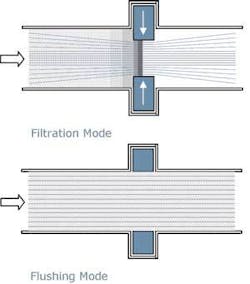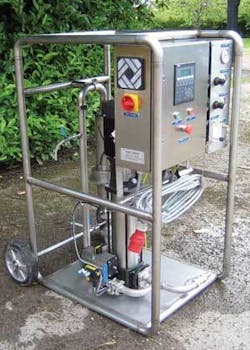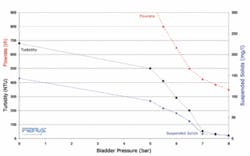Tarmac reuses water, meets EA discharge requirements
The Fibra filter, a low-energy, chemical-free, progressive depth filter, is widely applied in liquid filtration applications, incorporates optional efficient gas transfer through production of micro-bubbles, and features configurable particle removal efficiency.
Full-scale Fibra filters have been installed at two Tarmac pre-cast concrete sites in the UK to remove contaminants from wastewater. Tarmac is the UK’s leading manufacturer of factory engineered precast concrete for use in the road, rail, water, commercial, sport and leisure, industrial and government markets.
Fibra’s solution has proven particularly effective at sites that have traditionally discharged wastewater into sewerage systems because of the difficulties of on-site treatment. The Fibra process overcomes this problem by filtering particles down to sub-micron levels through highly efficient progressive depth filtration. The filters are available from the UK company Fibra Technology Limited.
The Fibra filter enables reuse of wastewater by effectively filtering out the contaminants.
In contrast to existing filtration technology, Fibra technology filters parallel to the flow direction as shown in Figure 1. The filter comprises an “in-line” fiber bundle within a stainless steel cylinder. In filtration mode the flow moves through the cylinder to a point where a flexible compression bladder acts on the fibers to constrict the flow.
Particles are retained in gaps between the compressed fibres; altering bladder pressure varies the degree of compression. The progressive narrowing of pore spaces between fibers provides the significant advantages of low pressure loss and natural grading through size exclusion. Optimisation of bladder pressure and fiber size allows precise control of particle removal efficiency.
The Fibra process has a fast, efficient and fully automated “Flushing” mode during which bladder pressure is removed to open up the fibers and solids are transferred to waste. The sequence takes five to ten seconds and uses a small quantity of feed liquid which in most cases is incoming wastewater. The retentate is either sent to waste or back to source (i.e. primary settlement).
The Fibra filter has the advantages of high deposit capacity and low energy requirements with no consumables required except electricity. Mounted on a durable frame, the filter is supplied complete with all necessary instrumentation and control equipment.
Other applications for the process include broad-spectrum particle filtration, membrane pre-filtration, industrial wastewater treatment, groundwater clarification, food and beverage applications, sewage oxidation, mine wastewater treatment, and metal cutting lubricant and coolant filtration.
Extensive pilot testing was undertaken at Tallington prior to Tarmac’s purchase of a full-scale Fibra system. The feed turbidity was around 1000 NTU during the trial and maximum TSS concentrations were 150 mg/l. The treated water had to meet an EA discharge standard of 20 mg/l.
Varying the bladder pressure, fiber material and size can optimize particle removal efficiency, so various fiber types were evaluated initially. By using 0.125-mm-diameter fibers at eight-bar bladder pressure, treated water had a turbidity of 190 NTU and a TSS level of 66 mg/l. By optimising the fiber size at 0.1-mm-diameter and maintaining bladder pressure, 10 NTU turbidity and 8 mg/l TSS were achievable, corresponding to removal rates of 99% and 94% respectively. The potential exists to re-use the filtrate as process water on-site due to the low TSS achieved.
Figure 3 shows use of the 0.1-mm-diameter fiber in the trial. The graph plots turbidity, suspended solids and flow rate achieved from the test filter versus the bladder pressure. The graph confirms that as the bladder pressure increases so does the level of filtration. The graph shows that the optimum bladder pressure for achieving a turbidity of less than 50 NTU is around 6.8 bar relating to a flow achievable from the single 10-cm test unit of approximately 450 l/h. Data from the trial enabled Fibra to optimise the design for the full-scale plant at Tallington.
Author’s Note
David Griffiths is the managing director of Fibra Technology Limited, based in Pangbourne, Berkshire, UK. Email: [email protected]



